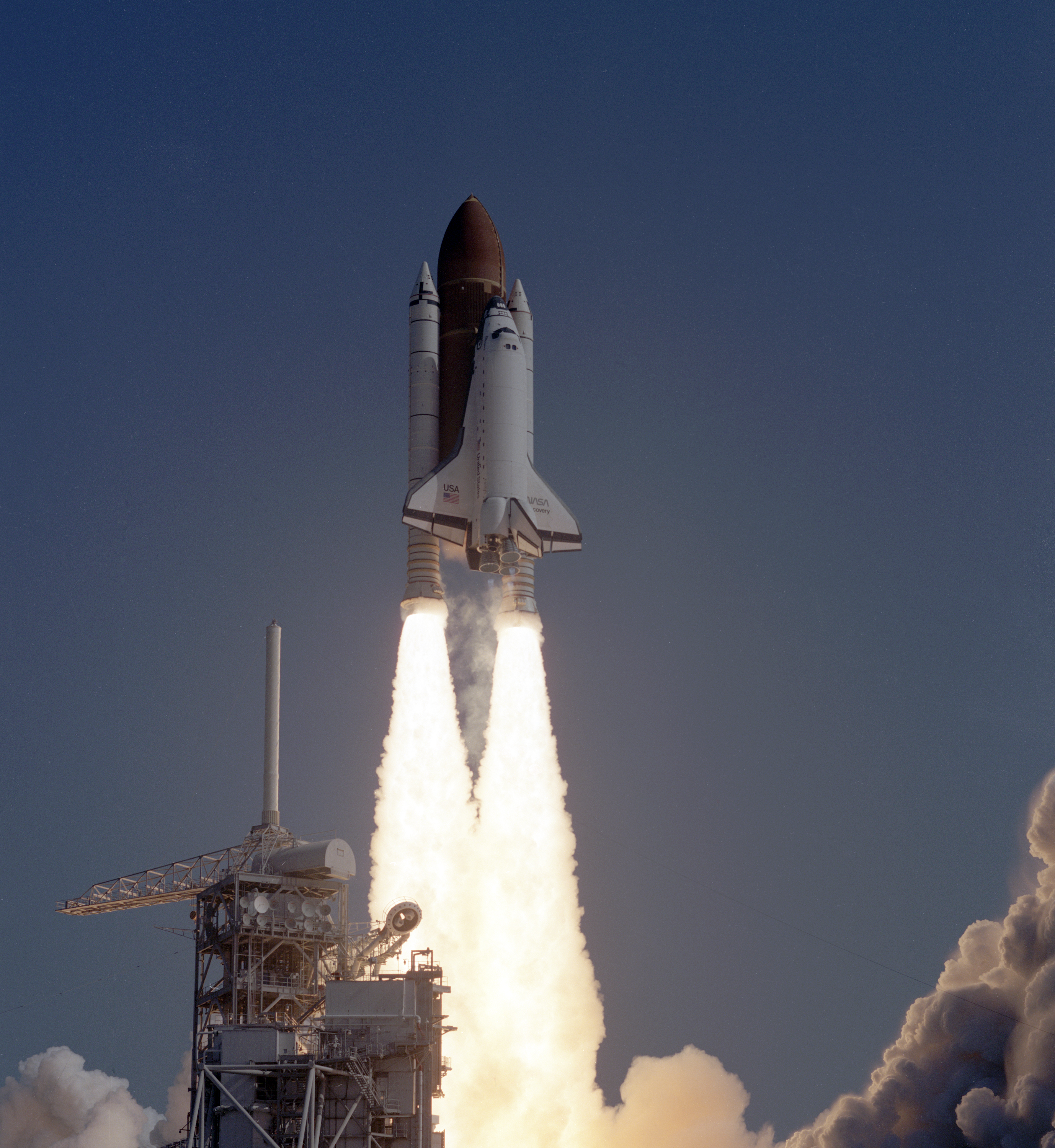TDRS-4 on:
[Wikipedia]
[Google]
[Amazon]
TDRS-4, known before launch as TDRS-D, is an American
 TDRS-D was launched aboard during the STS-29 mission in 1989. ''Discovery'' launched from Launch Complex 39B at the
TDRS-D was launched aboard during the STS-29 mission in 1989. ''Discovery'' launched from Launch Complex 39B at the


communications satellite
A communications satellite is an artificial satellite that relays and amplifies radio telecommunication signals via a transponder; it creates a communication channel between a source transmitter and a receiver at different locations on Earth. C ...
, of first generation, which was operated by NASA
The National Aeronautics and Space Administration (NASA ) is an independent agency of the US federal government responsible for the civil space program, aeronautics research, and space research.
NASA was established in 1958, succeeding t ...
as part of the Tracking and Data Relay Satellite System
The U.S. Tracking and Data Relay Satellite System (TDRSS) is a network of American communications satellites (each called a tracking and data relay satellite, TDRS) and ground stations used by NASA for space communications. The system was desig ...
from 1989 until 2011. It was constructed by TRW, based on a custom satellite bus
A satellite bus (or spacecraft bus) is the main body and structural component of a satellite or spacecraft, in which the payload and all scientific instruments are held.
Bus-derived satellites are opposed to specially produced satellites. Bus-d ...
which was used for all seven of the first generation TDRS satellites.
History
 TDRS-D was launched aboard during the STS-29 mission in 1989. ''Discovery'' launched from Launch Complex 39B at the
TDRS-D was launched aboard during the STS-29 mission in 1989. ''Discovery'' launched from Launch Complex 39B at the Kennedy Space Center
The John F. Kennedy Space Center (KSC, originally known as the NASA Launch Operations Center), located on Merritt Island, Florida, is one of the National Aeronautics and Space Administration's (NASA) ten field centers. Since December 1968 ...
at 14:57:00 UTC on 13 March 1989. TDRS-D was deployed from ''Discovery'' a few hours after launch, and was raised to geostationary orbit
A geostationary orbit, also referred to as a geosynchronous equatorial orbit''Geostationary orbit'' and ''Geosynchronous (equatorial) orbit'' are used somewhat interchangeably in sources. (GEO), is a circular geosynchronous orbit in altitud ...
by means of an Inertial Upper Stage
The Inertial Upper Stage (IUS), originally designated the Interim Upper Stage, was a two-stage, solid-fueled space launch system developed by Boeing for the United States Air Force beginning in 1976 for raising payloads from low Earth orbit to h ...
.
Deployment
The twin-stage solid-propellant Inertial Upper Stage made two burns. The first stage burn occurred shortly after deployment from ''Discovery'', and placed the satellite into ageostationary transfer orbit
A geosynchronous transfer orbit or geostationary transfer orbit (GTO) is a type of geocentric orbit. Satellite, Satellites that are destined for geosynchronous orbit, geosynchronous (GSO) or geostationary orbit (GEO) are (almost) always put into ...
(GTO). At 03:30 UTC on 14 March 1989, it reached apogee
An apsis (; ) is the farthest or nearest point in the orbit of a planetary body about its primary body. For example, the apsides of the Earth are called the aphelion and perihelion.
General description
There are two apsides in any ellip ...
, and the second stage fired, placing TDRS-D into geostationary orbit
A geostationary orbit, also referred to as a geosynchronous equatorial orbit''Geostationary orbit'' and ''Geosynchronous (equatorial) orbit'' are used somewhat interchangeably in sources. (GEO), is a circular geosynchronous orbit in altitud ...
. At this point, it received its operational designation, TDRS-4. It was placed at a longitude
Longitude (, ) is a geographic coordinate that specifies the east–west position of a point on the surface of the Earth, or another celestial body. It is an angular measurement, usually expressed in degrees and denoted by the Greek letter l ...
41.0° West of the Greenwich Meridian
The historic prime meridian or Greenwich meridian is a geographical reference line that passes through the Royal Observatory, Greenwich, Royal Observatory, Greenwich, in London, England. The modern IERS Reference Meridian widely used today ...
, from where it provided communications services to spacecraft in Earth orbit, including the Space Shuttle
The Space Shuttle is a retired, partially reusable low Earth orbital spacecraft system operated from 1981 to 2011 by the U.S. National Aeronautics and Space Administration (NASA) as part of the Space Shuttle program. Its official program na ...
and International Space Station
The International Space Station (ISS) is the largest modular space station currently in low Earth orbit. It is a multinational collaborative project involving five participating space agencies: NASA (United States), Roscosmos (Russia), JAXA ...
. In 2005, it was relocated to 46.0° West.
Retirement
TDRS-4 completed its planned mission in December 2011, and was subsequently removed to agraveyard orbit
A graveyard orbit, also called a junk orbit or disposal orbit, is an orbit that lies away from common operational orbits. One significant graveyard orbit is a supersynchronous orbit well beyond geosynchronous orbit. Some satellites are moved int ...
above GEO orbit belt, per International Telecommunication Union
The International Telecommunication Union is a specialized agency of the United Nations responsible for many matters related to information and communication technologies. It was established on 17 May 1865 as the International Telegraph Unio ...
(ITU) and United Nations (UN) recommendations. In May 2012, NASA reported that the orbit-raising manoeuvre had been completed successfully, and the spacecraft had been retired.

See also
*List of TDRS satellites
This is a list of Tracking and Data Relay Satellites. TDRS spacecraft are all in geostationary orbit and are operated by the United States National Aeronautics and Space Administration, and are used for communication between NASA facilities and ...
References
{{DEFAULTSORT:Tdrs-4 Derelict satellites orbiting Earth Spacecraft launched in 1989 TDRS satellites Spacecraft launched by the Space Shuttle